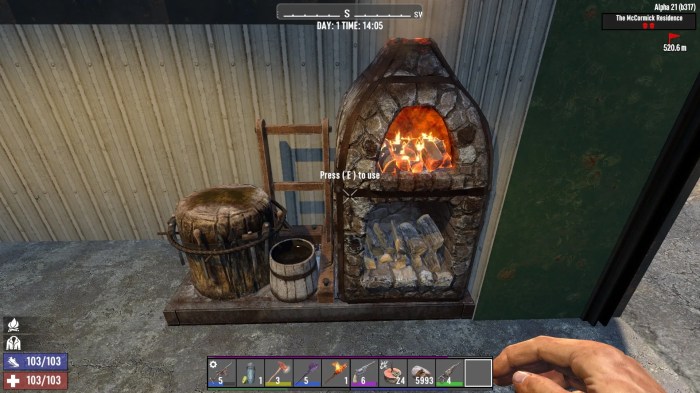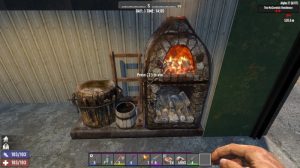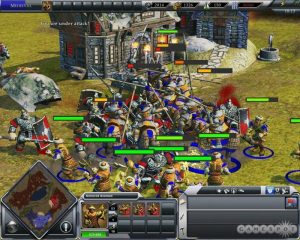
Embark on a thrilling journey in 7 Days to Die, where survival is key and danger lurks around every corner. Dive into a world filled with crafting, exploration, and fierce battles as you fight to stay alive in a post-apocalyptic landscape.
Unravel the mysteries of this unforgiving world and test your skills in building, fortifying, and strategizing to outlast the undead hordes. Are you ready to face the challenges that await in 7 Days to Die?
Overview of 7 Days to Die
Days to Die is a survival horror video game set in an open-world post-apocalyptic environment. Players must scavenge resources, craft items, and build shelters to survive against hordes of zombies and other threats.
Gameplay Mechanics and Objectives
- Players must manage their hunger and thirst levels, as well as monitor their health and stamina.
- Crafting is a crucial aspect of the game, allowing players to create weapons, tools, and structures to aid in their survival.
- Exploration is key to finding valuable resources, such as food, water, and materials, while also uncovering hidden locations and secrets.
- Combat plays a significant role, requiring players to fend off zombies and hostile survivors using a variety of weapons and tactics.
Open-World Environment and Survival Aspects
- The game world is procedurally generated, offering a unique experience each time players start a new game.
- Day and night cycles impact gameplay, with more dangerous enemies appearing at night.
- Players can build and fortify bases to protect themselves from threats, including zombie hordes and environmental dangers.
- Surviving the 7th day is a major objective, as it brings the toughest challenges and the largest zombie horde.
Gameplay Mechanics
In 7 Days to Die, players must navigate a post-apocalyptic world filled with zombies while managing resources, crafting items, and surviving the harsh environment. Understanding the gameplay mechanics is crucial to progress in the game.
Crafting System
The crafting system in 7 Days to Die is a fundamental aspect of gameplay. Players can gather resources from the environment, such as wood, stone, and metal, to craft a variety of items, weapons, and tools. Crafting allows players to create shelter, weapons for defense, and essential items for survival. It is essential to explore and scavenge for resources to unlock new crafting recipes and improve survival chances.
Day-Night Cycle
The day-night cycle in 7 Days to Die has a significant impact on gameplay. During the day, players can explore the world, gather resources, and build their base without much threat from zombies. However, as night falls, the zombies become more aggressive and dangerous, posing a greater threat to the player. Players must prepare themselves by fortifying their base, setting up traps, and stocking up on supplies to survive the night.
Combat Mechanics
Combat in 7 Days to Die involves a mix of ranged and melee weapons to fend off zombies and other threats. Players must aim carefully and time their attacks to effectively take down enemies. Strategies such as headshots, using cover, and utilizing traps can help players survive encounters with zombies and hostile creatures. It is crucial to manage resources and choose the right weapons for each situation to maximize combat effectiveness.
Multiplayer Features
In 7 Days to Die, players have the option to engage in multiplayer gameplay, allowing for cooperative and competitive interactions with other players.
Cooperative Gameplay Options
- Players can team up with friends or other online players to survive together in the post-apocalyptic world.
- Collaboration is key in building defenses, scavenging resources, and fending off hordes of zombies.
- Working together can lead to more efficient base-building and resource management.
Player Interactions and Collaborations
- Players can communicate through in-game chat or voice chat to strategize and coordinate their actions.
- Sharing resources, weapons, and tools among teammates can help everyone thrive in the harsh environment.
- Collaborative efforts can lead to the discovery of hidden loot and the completion of challenging objectives.
Competitive Aspects and Player Versus Player Encounters
- While cooperation is encouraged, players can also engage in PvP combat to test their skills against each other.
- Competing for resources, territory, and dominance adds an additional layer of challenge to the gameplay experience.
- Player versus player encounters can result in intense battles and rivalries, adding excitement and unpredictability to the game.
Building and Fortification
Building and fortification are crucial aspects of surviving in 7 Days to Die. Players must construct sturdy structures to protect themselves from zombies and other threats while also customizing their bases to suit their needs.
Building Mechanics and Customization Options
Building in 7 Days to Die involves gathering resources like wood, stone, and metal to construct various types of structures. Players can craft walls, floors, doors, windows, and more to create their ideal base. Additionally, the game offers a wide range of customization options, allowing players to paint and decorate their structures to their liking.
Fortifying Structures Against Threats
To fortify their bases against zombies and other dangers, players can set up traps, barricades, and defensive structures. Reinforcing walls and adding spikes or barbed wire can help deter enemies and protect the base from attacks. It’s essential to strategize and fortify the base effectively to ensure survival.
Importance of Base Building
Base building is crucial in 7 Days to Die as it provides a safe haven for players to store resources, craft items, and defend against threats. A well-designed and fortified base can make the difference between life and death in the game. Players must continuously improve and expand their bases to withstand increasingly challenging hordes of zombies and survive in the post-apocalyptic world.
Exploration and Resources

In 7 Days to Die, exploration and resource gathering are essential for survival and progression. Players must venture out into the game world to scavenge for vital resources that will help them in fortifying their base, crafting weapons, and sustaining themselves.
Scavenging for Resources
Scavenging is a crucial aspect of the game, as players must search abandoned buildings, loot containers, and mine resources to gather materials like wood, stone, metal, and food. These resources are used for crafting, building, cooking, and repairing equipment.
Exploration Mechanics and Map Dynamics
The game world in 7 Days to Die is procedurally generated, providing a unique experience with every playthrough. Players can explore different biomes, including forests, deserts, and cities, each with its own set of resources and challenges. The map dynamics include points of interest, landmarks, and random encounters that add depth to the exploration.
Utilizing Resources for Survival and Progression
Resources gathered through exploration are vital for survival in the harsh world of 7 Days to Die. Players can use these resources to craft weapons, tools, fortifications, and even vehicles. Without proper resource management, players may struggle to defend against the hordes of zombies that come every 7 days, making resource gathering a top priority for progression.
Survival Aspects
In 7 Days to Die, players must prioritize their survival needs in order to thrive in the post-apocalyptic world. This includes managing food, water, shelter, health, and dealing with environmental hazards and threats.
Food, Water, and Shelter
One of the primary concerns for survival in the game is ensuring a stable supply of food and water. Players must scavenge for resources, hunt animals, or grow crops to meet their nutritional needs. Additionally, finding or building a secure shelter is essential to protect against enemies and environmental dangers.
Health and Wellness Management
- Players must monitor their health and wellness levels, which can be affected by injuries, illnesses, or lack of food and water.
- Healing items such as bandages, antibiotics, and painkillers can be used to restore health and combat infections.
- Resting and avoiding dangerous situations can also help in maintaining overall wellness in the game.
Dealing with Environmental Hazards and Threats
- Environmental hazards such as extreme temperatures, radiation, and toxic areas can pose a threat to players’ survival.
- Players can mitigate these hazards by wearing appropriate clothing, using protective gear, or seeking shelter in safe locations.
- Threats from zombies, wildlife, and other hostile survivors must also be dealt with using weapons, traps, or strategic planning.
Modding Community
The modding community around 7 Days to Die is vibrant and active, constantly creating new content to enhance the gameplay experience for players. Mods are user-created modifications that can range from simple tweaks to major overhauls, adding new features, items, mechanics, and more to the base game.
Popular Mods and Impact on Gameplay
Some popular mods in the 7 Days to Die community include Valmod, Darkness Falls, and War of the Walkers. These mods introduce new enemies, weapons, crafting recipes, and challenges that significantly change the way the game is played. They offer players the opportunity to explore different playstyles and strategies, keeping the game fresh and exciting even after multiple playthroughs.
- Valmod: This mod focuses on expanding the crafting system, adding new items, skills, and progression paths for players to explore. It also introduces new enemy types and challenges to test players’ survival skills.
- Darkness Falls: Known for its increased difficulty and complex progression system, Darkness Falls overhauls many aspects of the game, including new locations, quests, and enemies. It offers a challenging experience for seasoned players looking for a new adventure.
- War of the Walkers: With a strong emphasis on exploration and combat, War of the Walkers introduces new biomes, items, and enemies to the game. Players can expect a more dynamic and engaging world to explore with this mod installed.
Enhancing the Gaming Experience
Mods not only add new content to 7 Days to Die but also provide players with the flexibility to customize their gameplay experience according to their preferences. Whether players are looking for a more challenging survival experience, new content to explore, or a different playstyle altogether, mods offer a way to tailor the game to their liking. The modding community’s creativity and dedication continue to enrich the 7 Days to Die experience for players worldwide.
Connection to Battle Royale Games
When comparing 7 Days to Die with typical battle royale games, there are some notable differences and similarities to explore. While both genres involve survival elements, the gameplay mechanics and player engagement vary significantly.
Gameplay Mechanics
7 Days to Die focuses on long-term survival in a post-apocalyptic world, where players must scavenge for resources, build shelter, and defend against hordes of zombies. In contrast, battle royale games are fast-paced, with a shrinking play area forcing players into intense combat until only one remains.
Player Engagement and Survival Aspects
- 7 Days to Die encourages strategic planning and base building to withstand zombie attacks over time, fostering a sense of long-term survival.
- Battle royale games emphasize quick decision-making, resource management, and combat skills to outlast opponents in a shrinking play zone.
- Both genres require players to adapt to changing environments and threats, but the pace and focus differ significantly.
Genre Influence on Strategies and Objectives
- In 7 Days to Die, players prioritize fortification, resource management, and long-term survival goals, fostering a more methodical and strategic approach.
- On the other hand, battle royale games push players to engage in fast-paced combat, loot quickly, and adapt to unpredictable situations, emphasizing immediate survival and elimination of opponents.
- The genre influence on player strategies and objectives is evident in the contrasting gameplay styles and overall player experiences.
Online Gaming Community
Being part of the online gaming community surrounding 7 Days to Die adds a whole new layer of excitement and engagement to the game. Players have the opportunity to interact, collaborate, and compete with others, creating a dynamic and ever-changing gaming experience.
Player Interactions
Player interactions in 7 Days to Die range from cooperative base-building to intense PvP battles. Whether teaming up to survive against hordes of zombies or engaging in strategic raids on other players’ fortresses, the social aspect of the game adds depth and variety to gameplay.
Forums and Social Aspects
- Players often frequent online forums and communities dedicated to 7 Days to Die to share tips, strategies, and stories from their adventures in the game.
- Social media platforms are also used by players to connect, organize events, and showcase their in-game creations to a wider audience.
- Streaming and content creation within the community allow for entertainment and educational content related to the game, fostering a sense of camaraderie among players.
Enhanced Gaming Experience
Online play in 7 Days to Die enhances the overall gaming experience by providing a dynamic and unpredictable environment where every interaction with another player can lead to new challenges or opportunities. The sense of community and shared experiences make the game more immersive and enjoyable for all participants.
Real-Time Strategy Elements
In 7 Days to Die, players can engage in real-time strategy elements that add depth to the survival gameplay experience. Strategic decision-making plays a crucial role in determining the player’s success in navigating the dangers of the game world and ultimately surviving the zombie apocalypse.
Base Building and Defense
- Players must strategically plan and build their bases to withstand zombie attacks and other threats.
- Choosing the right materials, layout, and defensive structures is essential for long-term survival.
- Players can set traps, create chokepoints, and fortify their bases to fend off hordes of zombies effectively.
- Resource management and allocation are key components of successful base building and defense strategies.
Scavenging and Resource Management
- Strategic decision-making is crucial when scavenging for resources in the game world.
- Players must prioritize which resources to gather based on their immediate needs and long-term goals.
- Managing inventory space and knowing when to collect or leave certain resources can impact overall survival.
- Effective resource management is essential for crafting essential items, weapons, and tools to survive in the harsh environment.
Combat Tactics
- Players can employ various combat tactics to overcome enemies and threats in the game.
- Using stealth, distractions, and positioning can give players an advantage in combat situations.
- Strategic use of weapons, traps, and environmental elements can turn the tide of battle in the player’s favor.
- Understanding enemy behavior and weaknesses is vital for developing effective combat strategies.
Sports Simulation Games
When it comes to incorporating elements of sports simulation games, 7 Days to Die offers players the opportunity to engage in activities that mimic the challenges and strategies found in various sports. These elements add a unique twist to the traditional survival gameplay, providing a different kind of experience for players.
Sports-related Mechanics and Activities
Within 7 Days to Die, players can partake in hunting and gathering activities that simulate the resource management often seen in outdoor sports. The need to track down animals for food or materials and the thrill of the hunt add a sports-like element to the game. Additionally, the emphasis on stamina management during physical activities such as running and fighting can also be likened to the endurance required in sports.
Depth to Gaming Experience
- The incorporation of sports-related mechanics adds an extra layer of complexity to the gameplay, requiring players to think strategically about their actions and decisions.
- Players who enjoy sports simulation games may find familiar elements in 7 Days to Die, enhancing their overall gaming experience by combining survival aspects with sports-like challenges.
- The inclusion of these elements not only diversifies the gameplay but also appeals to a broader audience, attracting players who appreciate the competitive and skill-based nature of sports.
Mobile Casual Games Influence
Mobile casual games have had a significant influence on the gaming industry, including games like 7 Days to Die. These influences can be seen in various aspects of the game, catering to casual gaming audiences through simplified mechanics and gameplay features.
Influence of Mobile Casual Games
- Quick and Easy Gameplay: 7 Days to Die offers straightforward gameplay mechanics that are easy to pick up and play, similar to many mobile casual games. This appeals to casual players looking for a more relaxed gaming experience.
- Short Gaming Sessions: The game allows players to engage in short gaming sessions, making it ideal for casual gamers who may not have long stretches of time to dedicate to gaming.
- Accessibility: With its user-friendly interface and controls, 7 Days to Die makes it easy for casual players to jump in and start playing without a steep learning curve.
Best Online Games

Online gaming has become increasingly popular in recent years, with a wide range of titles catering to different preferences and playstyles. Among these, 7 Days to Die has carved out a unique space for itself in the online gaming landscape, offering a compelling mix of survival, exploration, and building elements that set it apart from other online games.
Comparative Analysis
Days to Die stands out among the best online games due to its immersive gameplay mechanics, dynamic multiplayer features, and extensive modding community. While other online games may focus on specific genres or gameplay styles, 7 Days to Die offers a versatile experience that appeals to a diverse player base. Its combination of survival aspects, building mechanics, and exploration elements creates a compelling and engaging gameplay loop that keeps players coming back for more.
- Features: 7 Days to Die offers a unique blend of survival, exploration, and building elements that set it apart from other online games. The game’s open-world environment and dynamic day-night cycle add depth and complexity to the gameplay experience.
- Popularity: While 7 Days to Die may not have the same level of mainstream popularity as some other online games, it has developed a dedicated and passionate player base that continues to support the game through its active modding community and online forums.
- Reception: The game has received generally positive reviews from both players and critics, with praise for its immersive gameplay, challenging survival aspects, and engaging multiplayer features. While some players may find the game’s complexity and difficulty level daunting, many appreciate the depth and replay value it offers.
Standout Title
What sets 7 Days to Die apart from other online games is its unique blend of survival, exploration, and building elements, combined with a strong emphasis on player creativity and community-driven content. The game’s open-world environment, dynamic gameplay mechanics, and extensive modding support make it a standout title in the online gaming landscape, offering players a rich and rewarding experience that encourages creativity, collaboration, and exploration.
- Immersion: 7 Days to Die immerses players in a post-apocalyptic world where survival is key, challenging them to scavenge for resources, fortify their bases, and fend off hordes of zombies. The game’s immersive atmosphere and tense gameplay create a sense of urgency and excitement that keeps players on their toes.
- Community: One of the key strengths of 7 Days to Die is its vibrant and active community, which contributes to the game’s longevity and success. Players can share their creations, mods, and tips with one another, fostering a sense of camaraderie and collaboration that enhances the overall gaming experience.
- Versatility: 7 Days to Die’s versatile gameplay mechanics, robust multiplayer features, and extensive modding support make it a standout title in the online gaming landscape. Whether players prefer to focus on survival, exploration, building, or combat, the game offers something for everyone, allowing for a personalized and engaging experience.
Empire Building Elements
In 7 Days to Die, players have the opportunity to engage in empire building mechanics that add a layer of depth and long-term goals to the gameplay experience.
Player Progression and Base Expansion
- As players progress in the game, they can expand and fortify their bases to create a stronghold against the zombie horde.
- Building new structures, upgrading existing ones, and strategically placing defenses are crucial for survival and growth.
- Player progression is tied to the expansion of their base, as unlocking new crafting recipes and resources allows for further development.
Territory Control
- Controlling territory is essential in 7 Days to Die as it determines the safety of the player’s base and access to valuable resources.
- Players can claim land, establish outposts, and defend their territory against rival players or zombie attacks.
- Maintaining control over key areas ensures a steady supply of resources and a strategic advantage in the game world.
Depth and Long-Term Goals
- Empire building in 7 Days to Die adds depth to the gameplay by providing players with a sense of progression and accomplishment.
- Setting long-term goals such as expanding a base, fortifying defenses, and conquering new territories gives purpose and direction to the player’s actions.
- The strategic planning required for empire building fosters critical thinking and decision-making skills, enhancing the overall gaming experience.
Survival Games Genre
In the realm of survival games, 7 Days to Die stands out as a unique and immersive experience that combines elements of crafting, exploration, and zombie survival. It offers players a challenging open-world environment where they must scavenge for resources, build shelter, and defend against the undead hordes.
Common Tropes, Mechanics, and Themes
Survival games often feature common tropes such as resource gathering, crafting, base building, and combat against hostile elements. Players are usually tasked with managing hunger, thirst, and health while navigating dangerous environments. Themes of isolation, resilience, and adaptation are prevalent in this genre.
Innovation and Divergence in 7 Days to Die
- Dynamic Blood Moon Events: 7 Days to Die introduces the unique concept of Blood Moon horde nights, where players must fend off massive waves of zombies. This adds an extra layer of challenge and excitement to the survival experience.
- Block-Based Building System: The game’s voxel-based building system allows players to create intricate structures and fortifications, offering a high level of customization and creativity in base construction.
- Randomly Generated Worlds: 7 Days to Die features procedurally generated worlds, ensuring that each playthrough offers a fresh and unpredictable environment for players to explore and survive in.
- Skill Progression System: The game includes a skill progression system that allows players to specialize in different areas such as crafting, combat, and survival. This adds depth and replay value to the gameplay experience.
- Environmental Threats: In addition to the zombie threat, players must contend with environmental hazards like extreme weather conditions, diseases, and wildlife. This variety of challenges keeps players on their toes and encourages strategic decision-making.
Last Word
As you gear up for the ultimate test of survival, remember to adapt, scavenge, and build wisely. In 7 Days to Die, every decision counts, and every moment is a fight for survival. Will you rise to the challenge and emerge victorious, or will you fall prey to the dangers that lurk in the shadows?
Questions Often Asked
How important is base building in 7 Days to Die?
Base building is crucial for survival as it provides protection against zombies and other threats, as well as a safe haven to store resources and craft items.
Can you play 7 Days to Die solo?
Yes, you can play solo, but the game also offers engaging multiplayer options for cooperative or competitive gameplay.
Are mods available for 7 Days to Die?
Yes, there is a thriving modding community that offers a variety of mods to enhance and customize your gaming experience.





